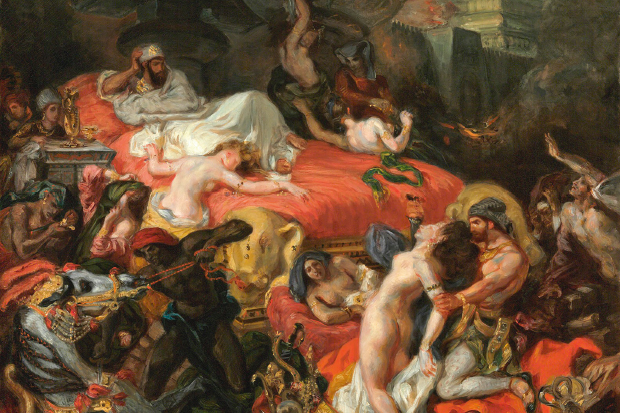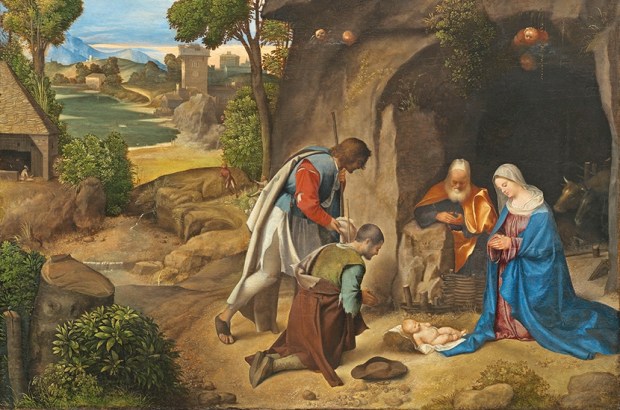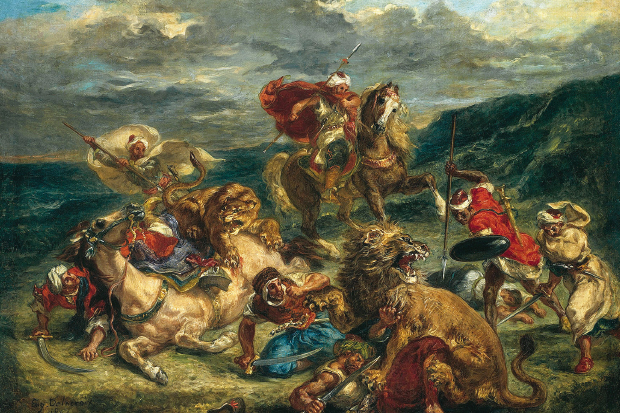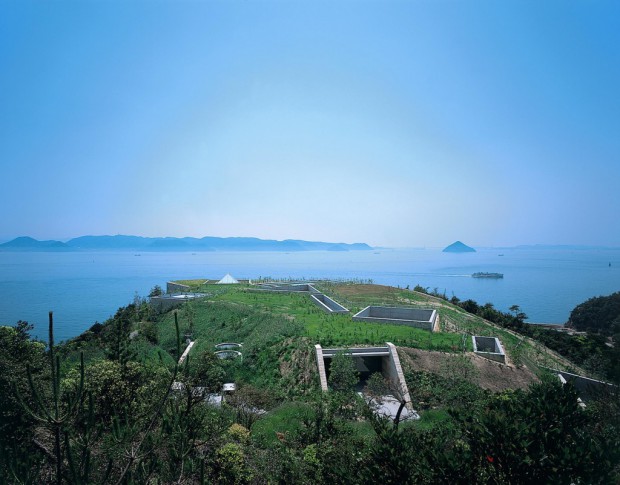At the Louvre the other day there was a small crowd permanently gathered in front of Delacroix’s ‘Liberty Leading the People’. They constantly took photographs of the picture itself, and sometimes of themselves standing in front of it. No such attention was given to the other masterpieces of French painting hanging nearby, including many by Delacroix. This painting from 1830 — with its glamorous, bare-breasted personification of liberté, Tricolore in hand, followed by heroic representatives of the working and middle classes — has become an international shorthand for France itself.
Whether or not this is a valid symbol of the country, it is a misleading guide to Delacroix’s own feelings about his native land, its revolutionary traditions and the modern world he watched developing around him in 19th-century Paris. He may have supported liberté, but fraternité and égalité not so much. A truer indication of his opinions is probably to be found in the mural that he painted in a half dome of the library of the Chamber of Deputies at the Palais Bourbon: ‘Attila and his Hordes Overrun Italy and the Arts’.
An exhibition next month at the National Gallery will present Delacroix as the apostle of modernism — and rightly so. He was revered as a predecessor by the impressionists and post-impressionists. A couple of hours before I was strolling through the Louvre last week, I was able to climb the scaffolding in the church of Saint-Sulpice where his wall paintings are currently under restoration. From a foot or two away, Delacroix’s vivid, vibrating colours and bold brush strokes looked startlingly reminiscent of those of Van Gogh or Gauguin.
There is, however, a paradox about the notion of Delacroix as the forerunner to the avant-garde of the 1880s and ’90s. He was a romantic pessimist, inclined to think that civilisation would always decline and barbarism inevitably return. It would be an exaggeration, Kenneth Clark thought, to say that Delacroix sympathised with Attila, but — Clark went on — he gave the leader of the Huns, trampling on the remains of ancient Roman culture, ‘the same irresistible energy’ as the lions and tigers he loved to paint.
Eugène Delacroix (1798–1863) was, like many highly creative people, a bundle of contradictions. He was an ardent lover of big cats, an artist whose images of tigers, Clark thought, were truer self-portraits than the pictures he made of his actual features. Meanwhile in everyday life Delacroix was an anglophile dandy — one of the first Parisians to wear suits cut in the English style — who aimed at a frigid self-control. ‘The mask is everything,’ he noted in 1823.
The contrast between Delacroix’s carefully preserved exterior and the swirling emotions within was summed up in a celebrated metaphor by his friend and admirer Charles Baudelaire. The painter resembled, Baudelaire wrote, ‘A volcanic crater artistically concealed beneath bouquets of flowers.’ He wanted to hide, as the poet put it, the ‘rage in his heart’ behind a glacial façade, but also — as the scholar Lee Johnson added — ‘his vulnerability and shyness’.
Delacroix suffered throughout his life from poor health, possibly caused by a tubercular infection that affected his throat and lungs. Furthermore, he was also plagued by a weak digestion, perhaps resulting from highly strung nerves. At work, carefully wrapped up against the cold in an old jacket buttoned to the chin, slippers and a muffler around the neck, he resembled neither a tiger nor a dandy.
He was a child of the French Revolution, but probably an illegitimate one. His ostensible father, Charles-François Delacroix, was minister of foreign affairs in the republican government. However, Charles-François Delacroix was impotent for many years as a result of an enormous growth on one of his testicles. This was removed in an operation — without anaesthetic, of course — in mid-September 1797. Eugène was born seven and a half months later. A persistent rumour claims that his true father was the great statesman Talleyrand, Charles-François Delacroix’s successor at the foreign ministry.
In 1805, Charles-François Delacroix died leaving only unwise investments and large debts. The painter came of age in the France of the restored monarchy, which he deplored (hence his support for the revolutionaries of 1830, which ejected the reactionary Charles X). But, like the heroes of his friend the novelist Stendhal, Delacroix deplored not just the stuffiness and corruption of Paris in the 1820s, but also the modern world itself with its new wealth and mass public. ‘I have never loved the crowd,’ he wrote in 1820, ‘nor all that the crowd feeds on.’
As time went on, his dislike focused on the bourgeoisie, often a bugbear for intellectuals and artists, in France and elsewhere. An acquaintance recalled that ‘among all those men who had a profound, ineradicable contempt for the bourgeois’, only Flaubert disdained them more than Delacroix. Even his perfect manners scarcely concealed his loathing for the middle classes who represented, he believed, a ‘wholly new barbarism’. He was, in other words, a snob both socially and intellectually.
‘Commercialism and love of pleasure are,’ he gloomily noted in 1857, ‘to the present way of thinking, the most compelling motives of the human soul.’ When the idea of progress — the ‘great chimera of modern times’ — was mentioned, he would ask where the contemporary equivalents of Raphael or Phidias were.
As it happened, Delacroix knew more geniuses than most people do, in any age. Chopin, Stendhal, Baudelaire and George Sand were among his circle (Balzac he knew but didn’t much like). He was an example of another paradox: the insider who feels like an outsider. One of the plagues of the modern age, Delacroix felt, was journalists — and in particular art critics, who were, it is true, unreasonably rude about his work. Delacroix was resolutely opposed by the artistic establishment of his day. It took him no fewer than seven attempts before he was elected, very late in life, to the Académie des Beaux-Arts. Yet he was loaded with well-paid commissions through the assistance of friends such as the politician and writer Adolphe Thiers.
So it is that some of Delacroix’s most majestic achievements are now hidden away in government premises. He painted a huge cycle on the theme of the rise and fall of civilisation in the library of the Palais Bourbon (seat of the French National Assembly). At one end Orpheus teaches the arts of civilisation to the — slightly dubious — ancient Greeks; at the other, Attila destroys them. This, and his depiction of a scene from Dante’s ‘Inferno’ in the dome of the library at the Palais du Luxembourg — seat of the Sénat — are not easy to visit these days because of the new barbarism of international terrorism.
They are evidence of another paradox. Delacroix was in many ways the final representative of the line of grand public pictures descended from Raphael and Michelangelo. The late works in Saint-Sulpice are the last great religious murals in the European tradition, but they were painted by a despairing agnostic. Delacroix believed that after death mankind faced ‘night, dreadful night’ — or so he told George Sand. He thought Voltaire had been correct to declare that while alive humanity was faced with a stark choice between being ‘convulsed with anxiety or lethargic with boredom’. There, too, he perhaps anticipated the predicament of the modern age.
Got something to add? Join the discussion and comment below.
Get 10 issues for just $10
Subscribe to The Spectator Australia today for the next 10 magazine issues, plus full online access, for just $10.
Delacroix and the Rise of Modern Art runs from 17 February to 22 May at the National Gallery.
You might disagree with half of it, but you’ll enjoy reading all of it. Try your first month for free, then just $2 a week for the remainder of your first year.














Comments
Don't miss out
Join the conversation with other Spectator Australia readers. Subscribe to leave a comment.
SUBSCRIBEAlready a subscriber? Log in